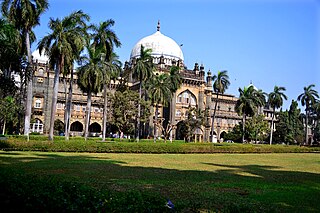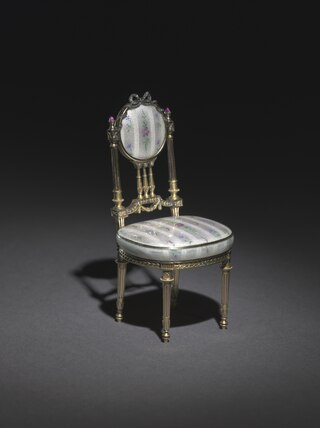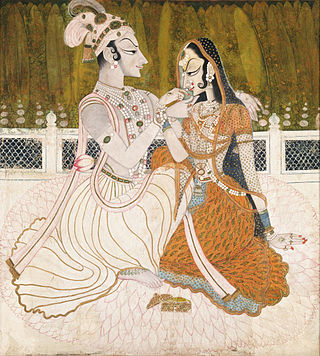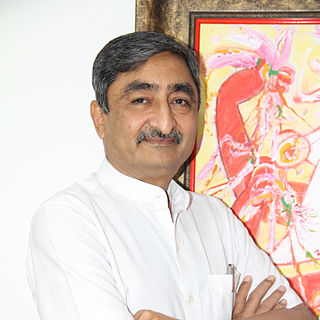Collections
The wide-ranging sculpture collection is unique, since all the major regional styles of the sub-continent are represented here on the Ground Floor, in Madhuri D. Desai Gallery. The outstanding pieces include the largest head of Buddha (c. 5th century) in stucco from Gandhara, the earliest cult image of Lord Rama (early 6th century) Gupta period from Deogarh (Madhya Pradesh), a rare figure of Matrika Indrani (6th century) from Shamlaji (Gujarat), the Adinath bronze image (c.7th-8th century) from Sirpur (near Nandurbar, Maharashtra), the Jaina bronze images from Ghogha (Dist.Bhavnagar, Gujarat) and some of the finest examples of Buddha images from Mathura, Nalanda and Nepal/ Tibet. Besides, the Madhuri D. Desai Gallery includes some very superb Chola sculptures (c. 10th-12th century) from Tamil Nadu. A majestic group of four Tirthankaras from Ladol dating between 11th and 13th centuries are displayed in Chaumukha arrangement. There are also in display 9 portrait statues of distinguished personages from Gujarat during the medieval period, which includes the Solanki king, Jayasimha Siddharaja. The portraits are inscribed with the date of V.S.1285 = 1228 (that is, during the Vaghela period) and the find spot is Harij, near Patan.
The museum has one of the finest collections of paintings in the Gujarati Jaina styles, some of which are painted before the Mughal period and are displayed in the Muni Punyavijayaji Gallery on the 1st Floor. The collection, which was assembled by the Muniji during the 1940s, has some rare illustrated wooden book covers (patli) created for palm-leaf manuscripts. The Jaina pilgrimage painting on cloth executed in 1433 at Champaner (Gujarat) is the earliest extant example of such a painting on cloth. Similarly, a Vijnaptipatra painted at Agra by the Mughal painter, Ustad Salivahana, in 1610, is the earliest painted document of its kind. It refers to the Mughal emperor Jahangir's farman prohibiting the killing of animals in his empire during the Jaina festival of Paryushana. The earliest painted paper manuscript of the Shantinath Charitra, dated V.S.1453 = 1396. has been recognized as a global treasure by UNESCO. Other exceptional examples on show include, the illustrated manuscripts of the Kalakacharya Katha (c. 1430) in Mandu style, the Matar Sangrahani Sutra (dated 1583), painted by Chitara Govinda, the Shripala Rasa (18th century), and painted Vijnapatipatra from Ahmedabad (dated 1796) in the late Gujarati style; several rare cosmological diagrams called Adhidvipa (c. 1440) and the Jaina Siddha-Chakra-Yantra.
On the 1st floor, eastern wing of the Muni Punyavijayaji Gallery has been designed with a section displaying the Leelavati Lalbhai Wood work Collection. It highlights the age old tradition of wood carving in Gujarat and other parts of India, mostly donated by Smt. Leelavati Lalbhai. The display includes Jaina Derasara, relief panels of Tirthankaras and other symbolic forms, carved pillars and decorative panels.
Among the noteworthy objects on display from the Shri Arvindbhai Collection, are a flamboyant Chola style Nataraja (11th century), an exuberant Nepali/ Tibetan bronze Mandala (18th century) and an elaborately decorated Chinese/ Japanese style cupboard in wood. This gift has widened the scope of the various collections to grow into a Museum of Asian Art in the Gujarat region.
Kasturbhai Lalbhai Collection of Indian Drawings comprises over 1855 Indian drawings and unfinished paintings. They represent most of the schools of Indian miniature paintings. Initially the collection was formed nearly 1000 years ago and now it is on display with the same objective of understanding the technical and the creative processes of traditional Indian miniature paintings. This substantial collection is represented here by a display of several dozen exquisite drawings of Indian miniature paintings belonging to various regional schools, between 17th and 19th centuries. The significant themes on view are Ramayana series and other numerous subjects.
The entire eastern wing on the first floor of Museum building was renovated with the financial assistance received from Ministry of Culture, New Delhi, 2012–2013. On the south-eastern side of the renovated wing, Priyakant T. Munshaw Gallery of Coinage has on display a representative collection of historical phases of coinage of India, which was posthumously gifted by Smt. Nandiniben Munshaw in 2013 The collection includes the earliest punched-marked coins called bentbar (c. 600 BC), Akbar's Din-i-Ilahi coin, Jahangir's Zodiac series in silver, Adil Shah's Larin (dated 1668) and contemporary currency.
On the north-western side of the First Floor, the Muni Punyavijayaji Gallery has a section devoted to Gopi-Anand Bead Work Collection. The art of Moti Guthana or Moti Poravanu is practiced mainly at Saurashtra and Kutch regions of Gujarat. This art has been in vogue since centuries but became wide spread during the late 19th century These patterns have been mostly used for household decoration and marriage ceremonies. Women of Kathi community in Gujarat have mastery over this art-form, who are fond of engaging in bead work for their domestic applications as well. The Gopi-Anand Bead Work Collection has been gifted to the museum by Shri Mahesh and Smt. Usha Pandya (March 2013), in memory of his parents, Shri Dalpatram and Gopiben Pandya. This interesting material augments the museum's holdings with a representative group of Gujarati handicrafts.

Chhatrapati Shivaji Maharaj Vastu Sangrahalaya, (CSMVS) originally named Prince of Wales Museum of Western India, is a museum in Mumbai (Bombay) which documents the history of India from prehistoric to modern times.

A miniature is a small illustration used to decorate an ancient or medieval illuminated manuscript; the simple illustrations of the early codices having been miniated or delineated with that pigment. The generally small scale of such medieval pictures has led to etymological confusion with minuteness and to its application to small paintings, especially portrait miniatures, which did however grow from the same tradition and at least initially used similar techniques.

Mughal painting is a style of painting on paper confined to miniatures either as book illustrations or as single works to be kept in albums (muraqqa), from the territory of the Mughal Empire in South Asia. It emerged from Persian miniature painting and developed in the court of the Mughal Empire of the 16th to 18th centuries. Battles, legendary stories, hunting scenes, wildlife, royal life, mythology, as well as other subjects have all been frequently depicted in paintings.

Indian painting has a very long tradition and history in Indian art, though because of the climatic conditions very few early examples survive. The earliest Indian paintings were the rock paintings of prehistoric times, such as the petroglyphs found in places like Bhimbetka rock shelters. Some of the Stone Age rock paintings found among the Bhimbetka rock shelters are approximately 10,000 years old.

Kasturbhai Lalbhai was an Indian industrialist and philanthropist. He co-founded the Arvind Mills along with his brothers and several other institutes. He was a cofounder of the Ahmadabad Education Society which initiated Ahmedabad University and the Indian Institute of Management Ahmedabad. He served as the chairman of historic and influential Anandji Kalyanji Trust that manages Shatrunjaya and several other Jain pilgrimage centers, for 50 years.

The Ṇamōkāra mantra or Navkar Mantra is the most significant mantra in Jainism, and one of the oldest mantras in continuous practice. This is the first prayer recited by the Jains while meditating. The mantra is also variously referred to as the Pancha Namaskāra Mantra, Namaskāra Mantra, Navakāra Mantra, Namaskāra Mangala or Paramesthi Mantra.

The National Museum in New Delhi, also known as the National Museum of India, is one of the largest museums in India. Established in 1949, it holds a variety of articles ranging from pre-historic era to modern works of art. It functions under the Ministry of Culture, Government of India. The museum is situated on Janpath. The blue–print of the National Museum had been prepared by the Gwyer Committee set up by the Government of India in 1946. The museum has around 200,000 works of art, mostly Indian, but some of foreign origin, covering over 5,000 years.

Ahmedabad is the industrial center in western India. after Mumbai. The gross domestic product of Ahmedabad metro was estimated at $80 billion in 2019. Ahmedabad is the largest contributor to the GDP of Gujarat state. With an estimated $68 billion out of $227 billion, textile and clothing in Ahmedabad is one of the oldest industries. It is the largest supplier of denim and one of the largest exporters of gems and jewellery in the country. Ahmedabad is one of the largest concentration of pharmaceutical and biotech companies in India. Ahmedabad hosts the headquarters of major public-sector banks Ahmedabad Dist Co Op Bank, Ahd Mercantile Co-Op Bank Ltd, Ahmedabad Mercantil Co Op Bank, Dena Bank, The Cosmos Co - Op Bank, Manager Gujarat Ambuja Co-Operative, The Gujarat State Co-operative Bank Ltd.Gujarat State Coop Bank, The Kalupur Bank, Ahmedabad Capital Bank, Kutch Bank co op, Bank of Rajasthan, Bank of Marwad.
The Calico Museum of Textiles is located in the city of Ahmedabad in the state of Gujarat in western India. The museum is managed by the Sarabhai Foundation.

Miniature art includes paintings, engravings and sculptures that are very small; it has a long history that dates back to prehistory. The portrait miniature is the most common form in recent centuries, and from ancient times, engraved gems, often used as impression seals, and cylinder seals in various materials were very important. For example most surviving examples of figurative art from the Indus Valley civilization and in Minoan art are very small seals. Gothic boxwood miniatures are very small carvings in wood, used for rosary beads and the like.
Lalbhai Dalpatbhai College of Engineering, is a state college located in Ahmedabad, Gujarat, India.

Government Museum and Art Gallery, Chandigarh, is a premier museum of North India having collections of Gandharan sculptures, sculptures from ancient and medieval India, Pahari and Rajasthani miniature paintings. It owes its existence to the partition of India in August, 1947. Prior to the partition, much of the collections of art objects, paintings and sculptures present here were housed in the Central Museum, Lahore, the then capital of Punjab. The museum has one of the largest collection of Gandharan artefacts in the world.

Apart from the architecture of Rajasthan, the most notable forms of the visual art of Rajasthan are architectural sculpture on Hindu and Jain temples in the medieval era, in painting illustrations to religious texts, beginning in the late medieval period, and post-Mughal miniature painting in the Early Modern period, where various different court schools developed, together known as Rajput painting. In both cases, Rajasthani art had many similarities to that of the neighbouring region of Gujarat, the two forming most of the region of "Western India", where artistic styles often developed together.

The Hutheesing family is a Jain family from Ahmedabad, Gujarat, India. Several temples and charitable institutions in Ahmedabad have been built or founded by members of this mercantile family. Krishna Hutheesing, a sister of Jawaharlal Nehru, was a member of this family by marriage.
Shantinatha Charitra is a Sanskrit text that describes the life of 16th Jain tirthankara Shantinatha. It was written in 1397 CE. This text has been registered into Memory of the World Programme by UNESCO.

State Museum, Lucknow is a prominent museum located in the capital city of Uttar Pradesh, India. The museum is currently located in the Nawab Wajid Ali Shah Zoological Gardens, Banarasi Bagh, Lucknow. The museum was established in 1863 from the collection of Colonel Abbot, and was given the status of ‘Provincial Museum’ before being renamed the ‘State Museum’ in 1950.
Lalbhai Dalpatbhai (1863-1912) was an industrialist and one of the first generation textile mill owners from Ahmedabad, who laid the foundation of the present-day Lalbhai group of Industries.

Anil Relia is an Indian art collector, known for his portrait collection. He has over 3000 portraits and his personal collection includes many miniature paintings, early photographs along with works of artists like Raja Ravi Varma, M. F. Husain, Hemen Majumdar, Bhupen Khakhar, Jyoti Bhatt, Haku Shah, K. G. Subramanyan, S.H. Raza, Thota Vaikuntam, Manu Parekh and many more.

Bharat Kala Bhavan is a university museum located in Banaras Hindu University, Varanasi, India. It has been instrumental in the dissemination of knowledge on Indian art and culture. It is one of the important touristic attractions in the Banaras Hindu University and in the city of Varanasi.
Chinubhai Chimanlal also commonly referred to as Chinubhai Mayor was industrialist, cotton textile mill owner and one of the scions of Lalbhai group. He was elected as first mayor of Ahmedabad Municipal Corporation.

















